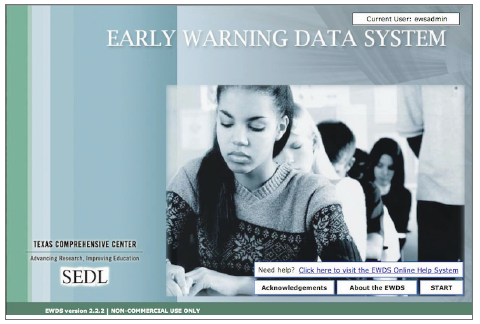ESC Materials
Flyer
The Early Warning Data System (EWDS) database application was developed by the Texas Comprehensive Center (TXCC) at SEDL and is based on the National High School Center’s (NHSC) Early Warning System (EWS) Tool (Excel version); it is freely available to schools and districts. The database tracks key ninth-grade indicators related to high school dropout (such as attendance, course failures, GPA) and automatically calculates on-track status. The customized database application also provides both predefined and custom reports showing which students are below the defined benchmark for each of the indicators. The information generated by this database is based on the school’s readily available data regarding student academic performance, attendance, and behavior. The data can be imported or entered manually, and reports can be viewed, printed, or shared via Microsoft Excel.
Identifying Students at Risk of Dropping Out
In addition to two primary indicators, the EWDS utilizes 12 attendance and academic risk indicators to flag students for interventions. Two primary high-yield indicators determine whether students are on-track or off-track for graduation. As student data are entered or imported, risk indicators are automatically updated and student flags are activated or de-activated.
Custom Fields
Up to five custom fields can be added to track additional student data such as TAKS scores or other information. Custom fields can be defined once and applied to all student records for a campus or district.
EWDS Webinar Archive
The archive will be available after November 12.

Intervention Tracking
Once students are identified as at-risk by the EWDS, interventions can be recorded and monitored. Because interventions can be coded by type, helpful summary reports may be created that allow interventions of varying types to be compared with student performance before, during, and after the period the intervention was in place.

For each intervention, the EWDS provides an area to capture information relating to the implementation and impact of the intervention, including comments, lessons learned, and recommendations for future action. This information can be very helpful as intervention modifications are made, based on observation and student performance.
Access to Resources for Dropout Prevention: Intervention Strategies
The EWDS also provides a list of recommended resources for research-based intervention strategies for dropout prevention. These resources include publications from such organizations as the National High School Center, the U.S. Department of Education’s Institute of Education Statistics (IES), the Texas Education Agency, and the Texas Comprehensive Center at SEDL. Users can also add their own recommended resources to the system.
Reports
Numerous reports are available in the EWDS, both predefined and custom. They can range from group reports, showing students within a cohort group matching certain indicators, to individual student reports that include interventions.

Integration with Excel
All EWDS reports, including both predefined and custom reports, can be either printed or saved as Excel files for easy sharing with relevant staff at a campus or district. All existing student data for any given cohort group can also be saved and opened in Excel.
Is the EWDS Research-Based?
The EWDS is adapted from the EWS Tool, which is based on research conducted by the Consortium on Chicago School Research and Johns Hopkins University. Their research on the identification of potential high school dropouts detected several indicators that were correlated to high school dropout in the areas of academic performance and attendance. In addition to the research-based indicators, behavior referral tracking is also provided in the database application in response to a request from the Texas Education Agency.
For an overview of research findings that determine how the EWS Tool flags "at-risk" students, see the NHSC's Early Warning Systems Guide available at http://www.betterhighschools.org/docs/IssueBrief_EarlyWarningSystemsGuide_081408.pdf
For more information about the EWDS or to download a free copy for evaluation, visit the Texas Comprehensive Center Web site at https://sedl.org/txcc/resources/ewds/
